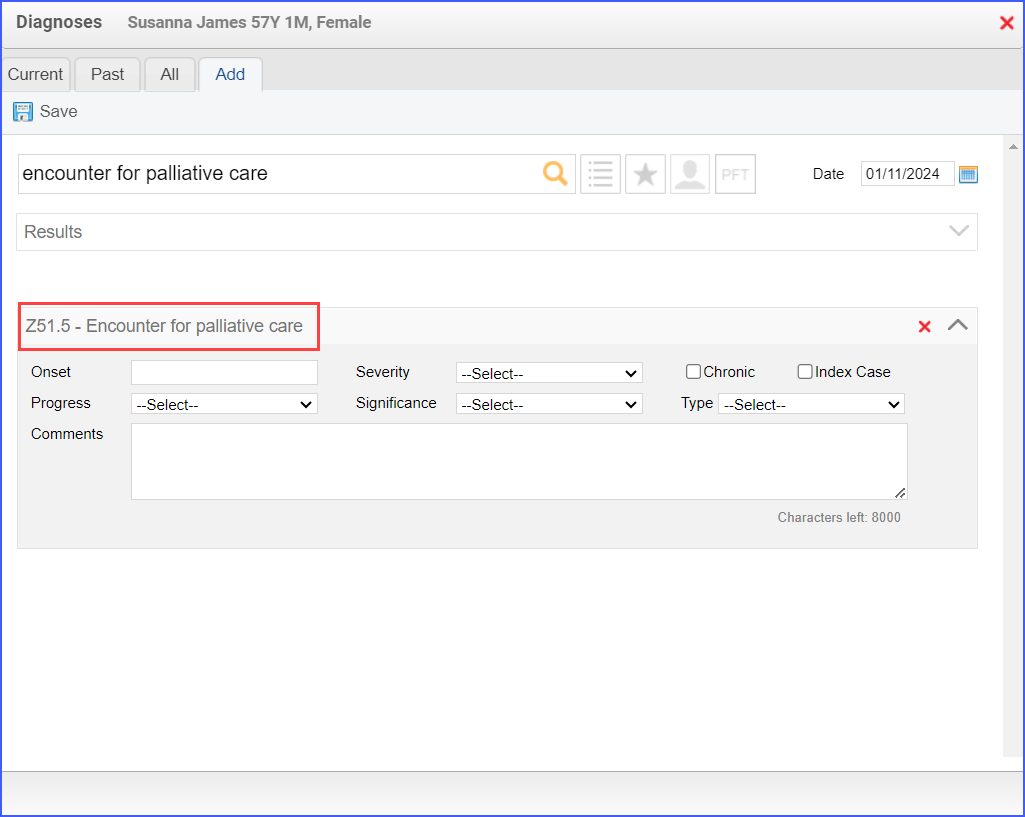CMS347v7 – Statin Therapy for the Prevention and Treatment of Cardiovascular Disease
| Statin Therapy for the Prevention and Treatment of Cardiovascular Disease | CMS347v6 | Percentage of the following patients – all considered at high risk of cardiovascular events – who were prescribed or were on statin therapy during the measurement period:
*All patients who were previously diagnosed with or currently have a diagnosis of clinical atherosclerotic cardiovascular disease (ASCVD), including an ASCVD procedure; OR *Patients aged 20 to 75 years who have ever had a low-density lipoprotein cholesterol (LDL – C) level ≥ 190 mg/dL or were previously diagnosed with or currently have an active diagnosis of familial hypercholesterolemia; OR *Patients aged 40-75 years with a diagnosis of diabetes; OR *Patients aged 40 to 75 with a 10-year ASCVD risk score of ≥ 20 percent. | |
|---|---|---|---|
| – INITIAL POPULATION- 1
All patients who were previously diagnosed with or currently have a diagnosis of clinical ASCVD, including an ASCVD procedure. An ASCVD diagnosis can include a diagnosis of any of the following:
An ASCVD procedure can include any of the following:
If Yes, then patient meets Denominator 1 risk category and does not need to be screened for other denominator criteria. If no, then screen for Denominator 2 risk category. | – DENOMINATOR – 1
Equals Initial Population 1 | – NUMERATOR – 1
Patients who are actively using or who receive an order (prescription) for statin therapy at any time during the measurement period. The Statin Therapy medication can include any of the following:
Note: ONLY statin therapy meets the measure numerator criteria (NOT other cholesterol lowering medications). | |
| – INITIAL POPULATION- 2
Patients aged 20 to 75 years at the beginning of the measurement period who have ever had a laboratory result of LDL-C ≥190 mg/dL or were previously diagnosed with or currently have an active diagnosis of familial hypercholesterolemia. If Yes, then patient meets Denominator 2 risk category and does not need to be screened for Denominator 3 criteria. If no, then screen for Denominator 3 risk category. | – DENOMINATOR – 2
Equals Initial Population 2 | – NUMERATOR – 2
Patients who are actively using or who receive an order (prescription) for statin therapy at any time during the measurement period. The Statin Therapy medication can include any of the following:
Note: ONLY statin therapy meets the measure numerator criteria (NOT other cholesterol lowering medications). | |
| – INITIAL POPULATION- 3
Patients aged 40 to 75 years at the beginning of the measurement period with Type 1 or Type 2 diabetes. If Yes, then patient meets Denominator 3 risk category and does not need to be screened for Denominator 4 criteria. If no, then screen for Denominator 4 risk category. | – DENOMINATOR – 3
Equals Initial Population 3 | – NUMERATOR – 3
Patients who are actively using or who receive an order (prescription) for statin therapy at any time during the measurement period. The Statin Therapy medication can include any of the following:
Note: ONLY statin therapy meets the measure numerator criteria (NOT other cholesterol lowering medications).
| |
| – INITIAL POPULATION- 4 Patients aged 40 to 75 years at the beginning of the measurement period with a 10-year ASCVD risk score (i.e., 2013 ACC/AHA ASCVD Risk Estimator or the ACC Risk Estimator Plus) of ≥ 20 percent during the measurement period. If Yes, then patient meets Denominator 3 risk category. If no, patient does NOT meet Denominator criteria and is NOT eligible for measure inclusion. | Equals Initial Population 4 | NUMERATOR-4 Patients who are actively using or who receive an order (prescription) for statin therapy at any time during the measurement period. The Statin Therapy medication can include any of the following:
Note: ONLY statin therapy meets the measure numerator criteria (NOT other cholesterol lowering medications). | |
Note: For all 4 denominator criteria, there must be a qualifying encounter during the measurement period as well. A qualifying encounter in this case can include any of the following:
– DENOMINATOR EXCLUSIONS:
– DENOMINATOR EXCEPTIONS:
Note: The documentation of medical reasons for not prescribing statin therapy should happen during a qualifying encounter (which can include any of the ones mentioned in the criteria for denominator). | |||
Application Workflow:
For Denominator 1:
- To record a diagnosis, navigate to Patient > Provider Note > Diagnoses. Click ‘Add’ and search for the relevant diagnosis. Fill out any details as needed and once done, click ‘Save’. Then click ‘Accept’ to add the diagnosis to the provider note.
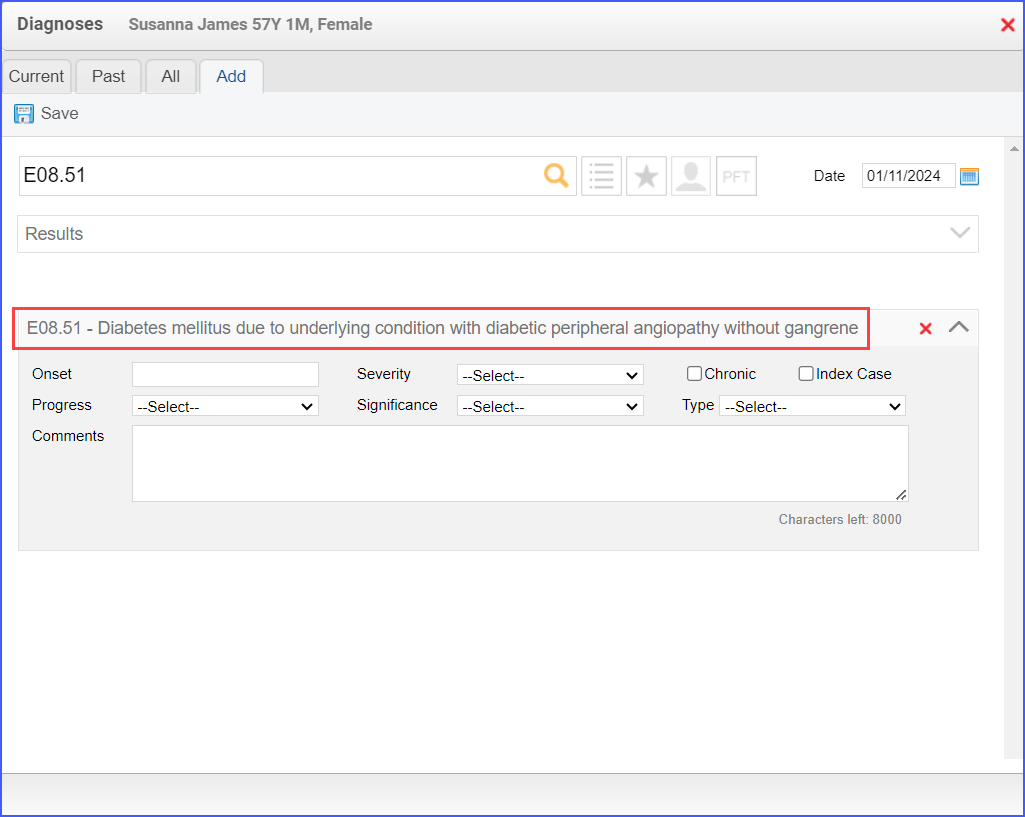
- The documentation of an ASCVD procedure can be done via Patient > Provider Note > Orders > Procedures. Here, click ‘Add’ and search for the relevant procedure. Fill out the details and once done, click ‘Save & Accept’ or ‘Sign & Accept’.
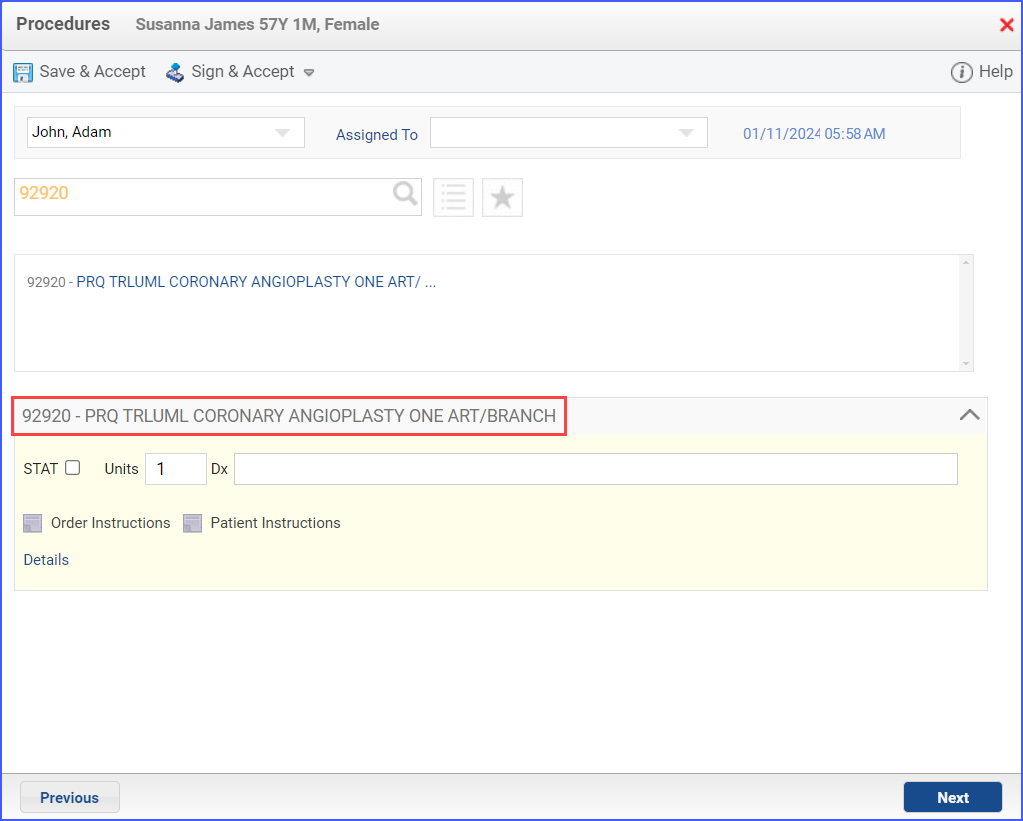
- To record an encounter, head over to Patient > Provider Note > Create Superbill. Under the ‘Procedure-CPTs’ heading, add the relevant encounter code.
For Denominator – 2:
- An LDL-C test can be ordered through Patient > Provider Note > Orders > Lab. Here, click ‘Add’ and select a laboratory. Then search for the relevant lab test and specify any detail needed. Once done, click ‘Save & Accept’ or ‘Sign & Accept’.
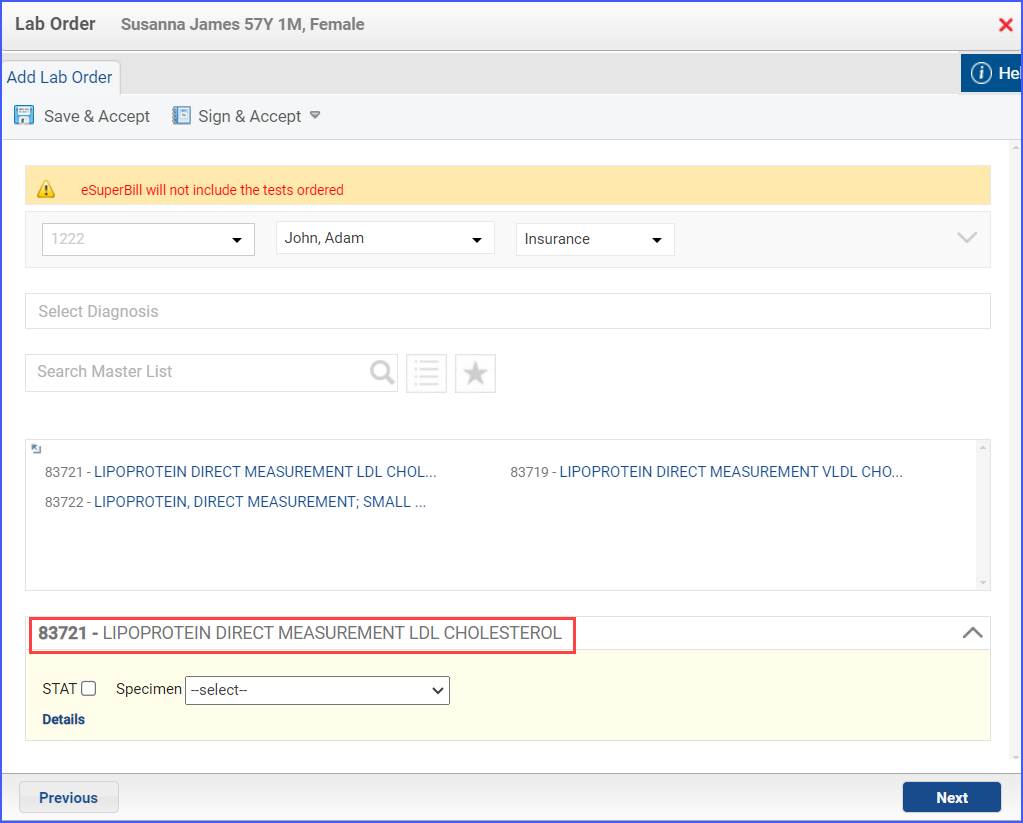
- To document the Hypercholesterolemia diagnosis, navigate to Patient > Provider Note > Diagnoses. Click ‘Add’ and search for the relevant diagnosis. Fill out any details as needed and once done, click ‘Save’. Then click ‘Accept’ to add the diagnosis to the provider note.
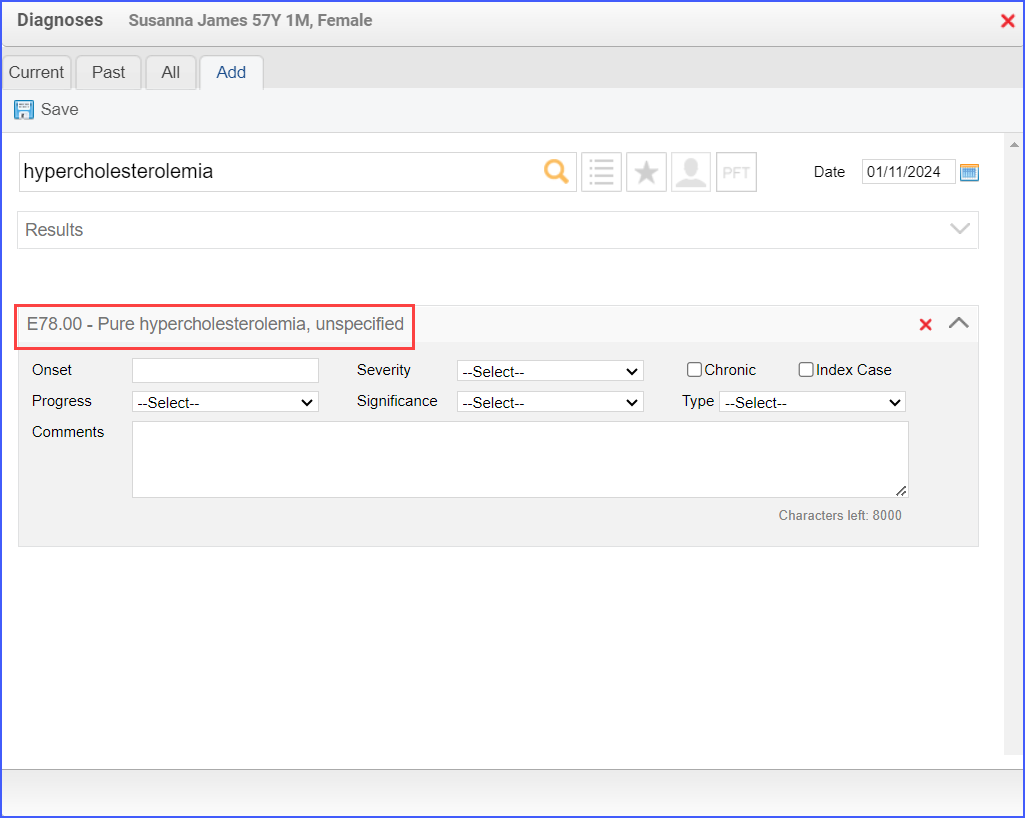
- To record an encounter, head over to Patient > Provider Note > Create Superbill. Under the ‘Procedure-CPTs’ heading, add the relevant encounter code.
For Denominator – 3:
- The diabetes diagnosis can be documented via Patient > Provider Note > Diagnoses. Click ‘Add’ and search for the relevant diagnosis. Fill out any details needed and once done, click ‘Save’. Then click ‘Accept’ to add the diagnosis to the provider note.
- To record an encounter, head over to Patient > Provider Note > Create Superbill. Under the ‘Procedure-CPTs’ heading, add the relevant encounter code.
For Denominator 4:
- To document a cardiovascular risk assessment and its result, navigate to Patient > Provider Note > Evaluations. Here, search for the relevant risk assessment, select ‘Performed’ as the status and input the numeric result in the respective ‘Result’ field. Once done, click ‘Save & Accept’ or ‘Sign & Accept’.
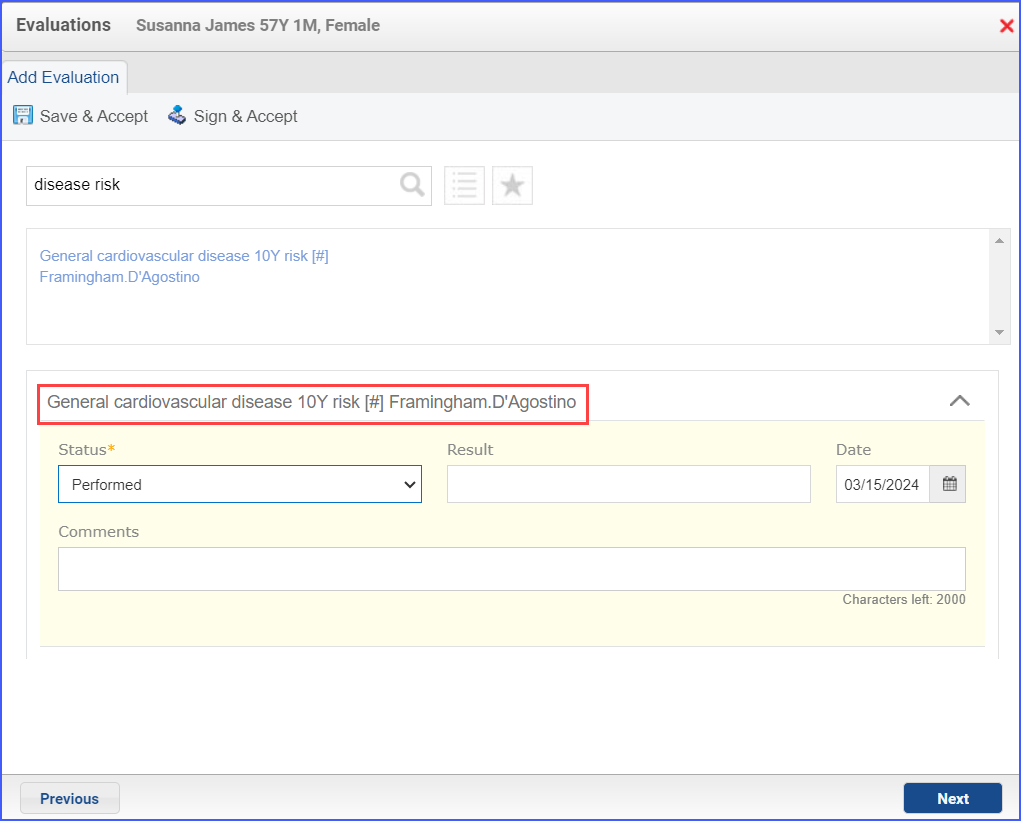
- The diagnoses for
- Diabetes
- Hypercholesterolemia
can be recorded through Patient > Provider Note > Diagnoses.
- An LDL-C test can be ordered via Patient > Provider Note > Orders > Lab. Here, click ‘Add’ and select a laboratory. Then search for the relevant lab test and specify any detail needed. Once done, click ‘Save & Accept’ or ‘Sign & Accept’.
Note: In order to count for Denominator 4, the patient must not have an ASCVD diagnosis or procedure before the measurement period ends.
For Numerator:
- To prescribe Statin Therapy, use the workflow Patient > Provider Note > Prescription. Click ‘Add’ and search for the relevant medication. Fill out the details as needed and once done, click ‘Prescribe’.
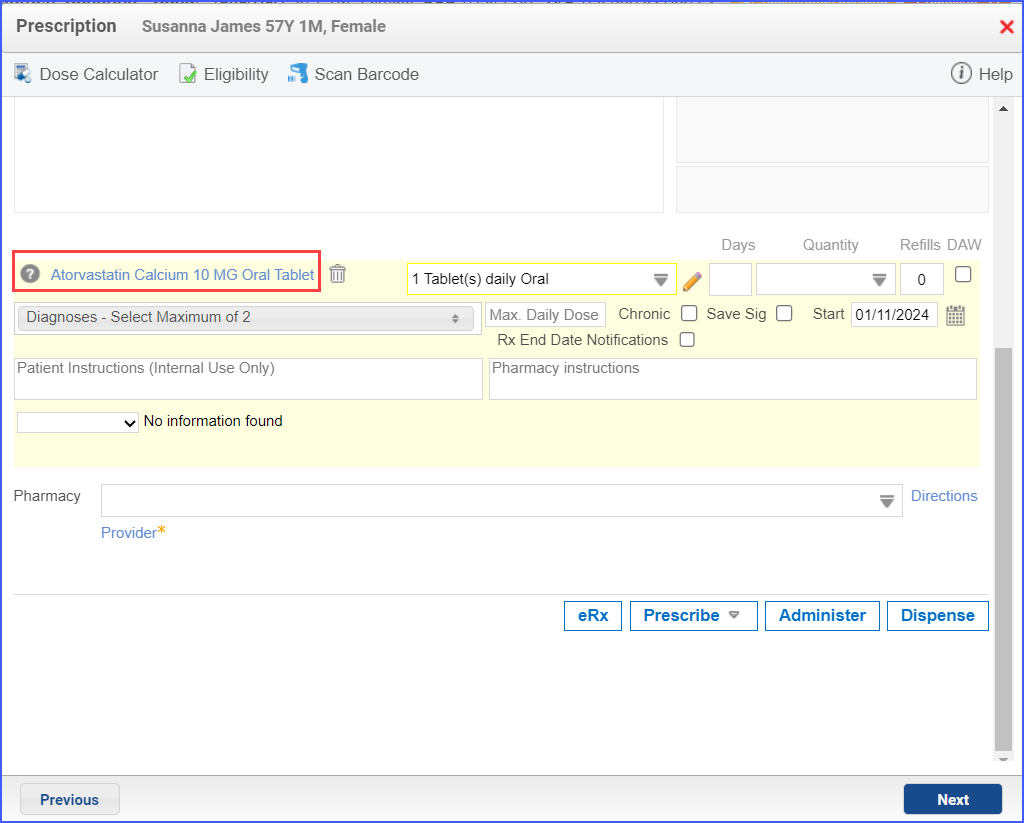
- Similarly, an active statin therapy intake can be recorded through Patient > Provider Note > Medications.
For Denominator Exclusions:
To document a diagnosis of rhabdomyolysis or pregnancy, navigate to Patient > Provider Note > Diagnoses. Here, click ‘Add’ and search for the relevant diagnosis. Fill out any details as needed and once done, click ‘Save’. Then click ‘Accept’ to add the diagnosis to the provider note.
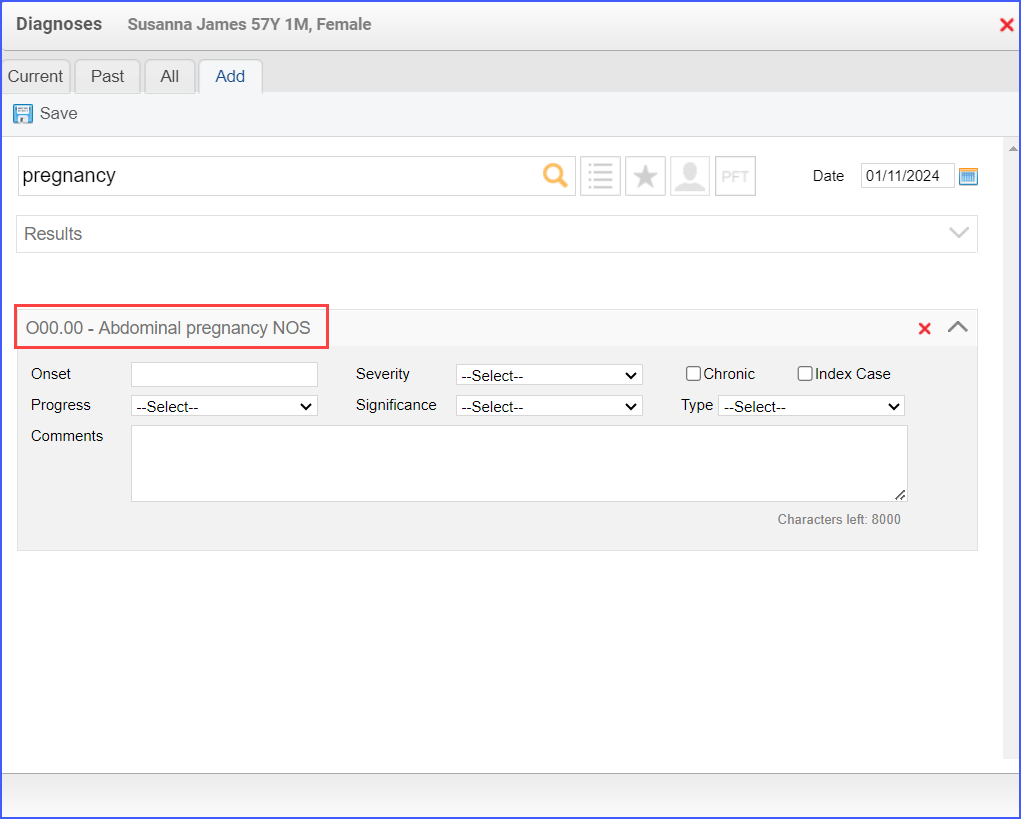
For Denominator Exceptions:
- To record an allergy or intolerance to statin medication, use the workflow Patient > Provider Note > Allergy. Click ‘Add’ and search for the relevant allergy or intolerance. Fill out any details as needed and once done, click ‘Save’. Then click ‘Accept’ to add the allergy to the provider note.
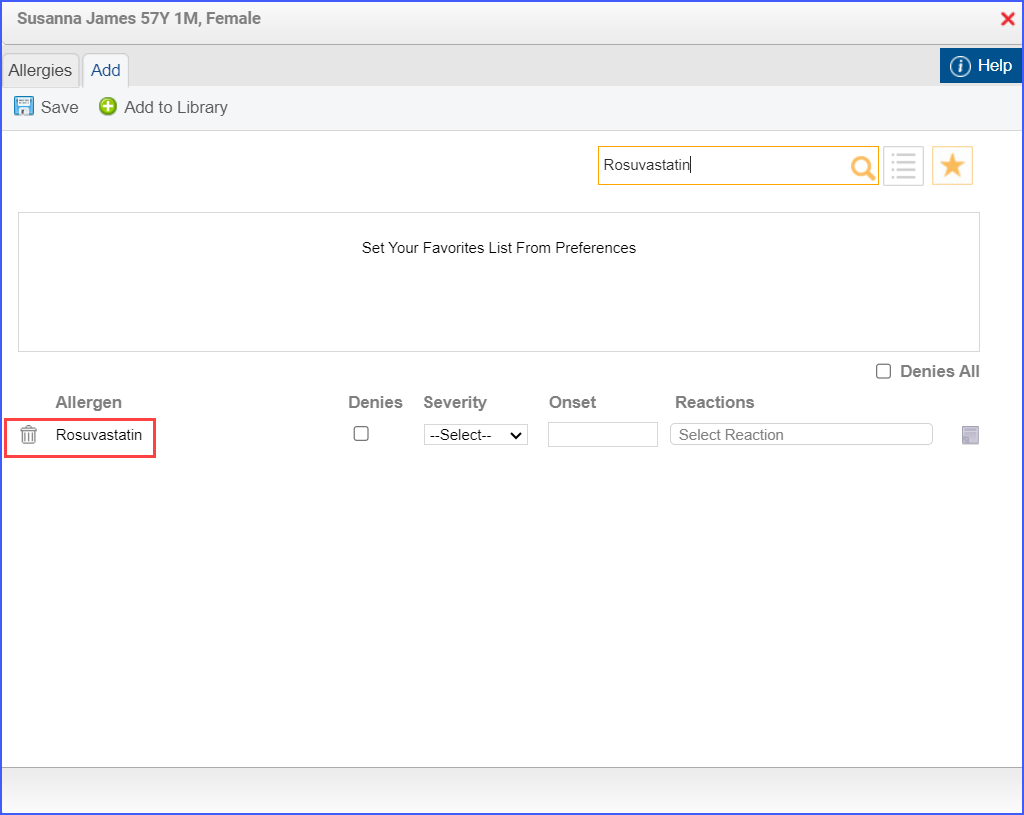
- For documenting a diagnosis, use the workflow Patient > Provider Notes > Diagnoses. Click ‘Add’ and search for the relevant diagnosis. Fill out any details needed, and once done, click ‘Save’.
- To document that a patient is receiving hospice care outside of a hospital or long-term care facility, navigate to Patient > Provider Note > Evaluations. Use the below mentioned codes to order or perform an intervention:
- 385763009: Hospice Care (Regime/Therapy)
- 385765002: Hospice Care Management (Procedure)
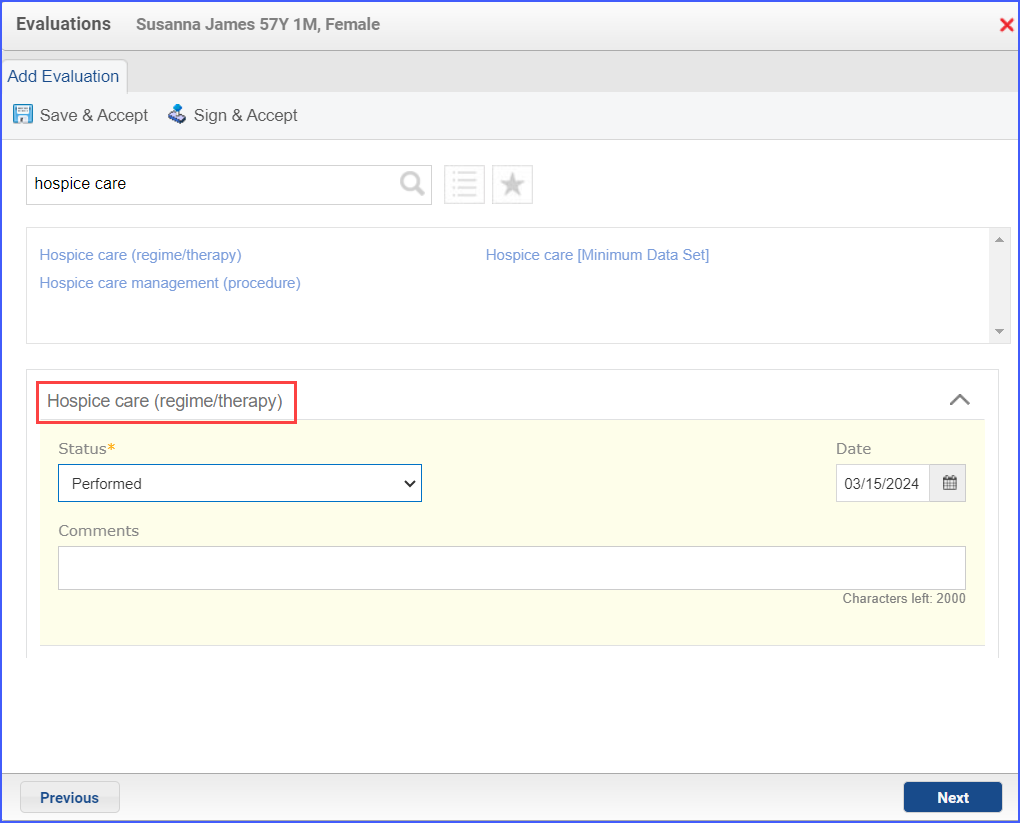
- To document an inpatient encounter, navigate to Patient > Provider Note > Evaluations.
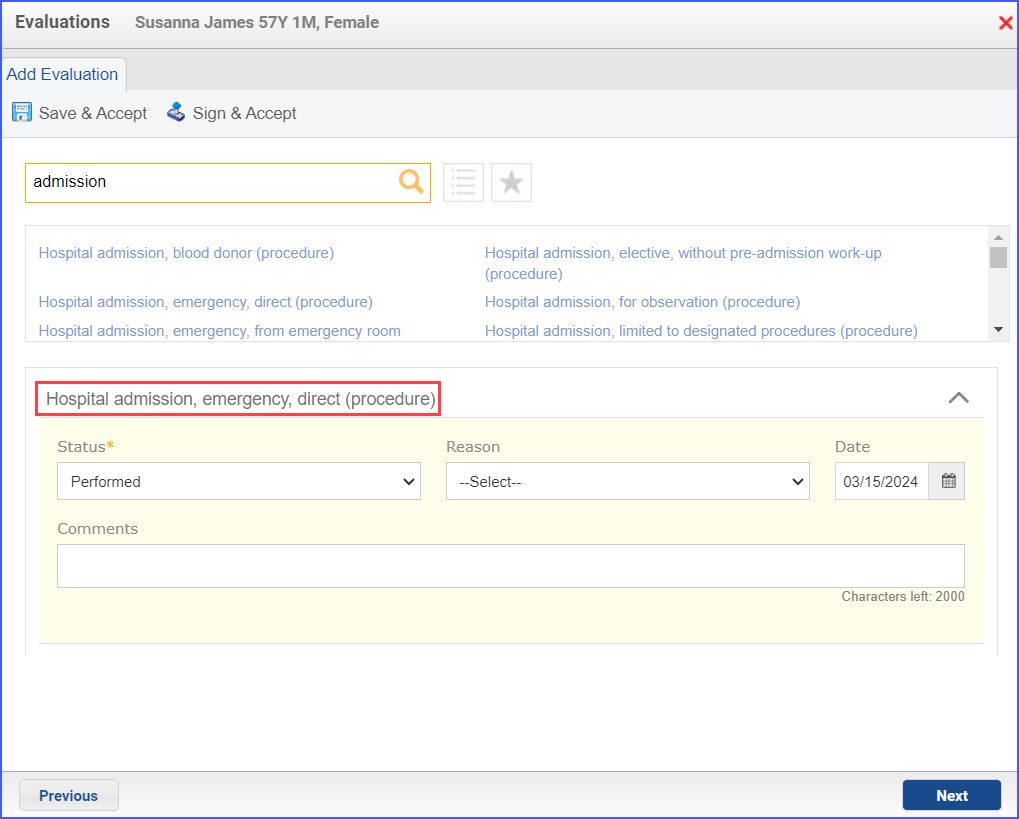
- To document a hospice care assessment, follow the workflow Patient > Provider Note > Evaluations. Click ‘Add’ and search for ‘Hospice Care [Minimum Data Set]’. Then select ‘Performed’ from the ‘Status’ dropdown and ‘Yes’ from the ‘Result’ field.
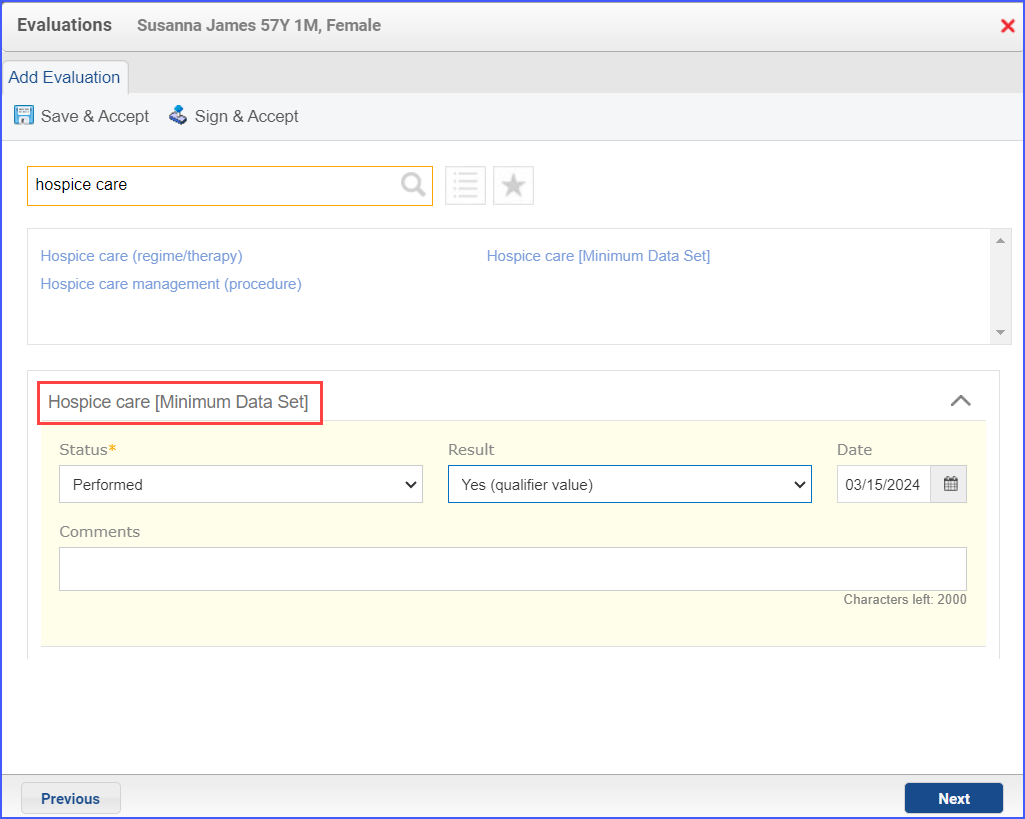
- A hospice encounter can be documented through Patient > Provider Note > Evaluations or Patient > Provider Note > Create Superbill.
- For patients receiving palliative care during the measurement period:
- To record the ‘Palliative Care Encounter’, head over to Patient > Provider Note > Create Superbill
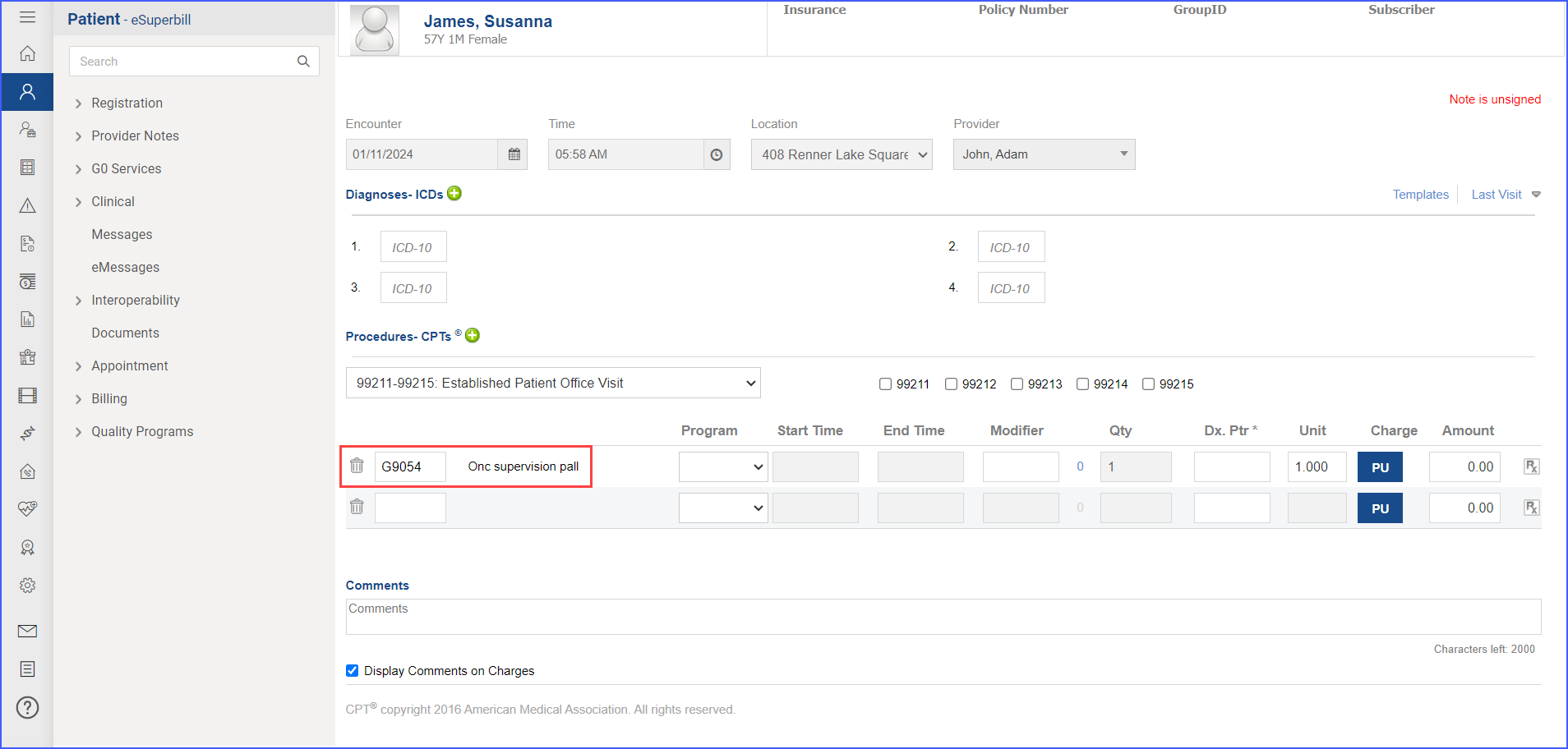
- To record the ‘Palliative Care Intervention’, use the workflow Patient > Provider Note > Evaluations.
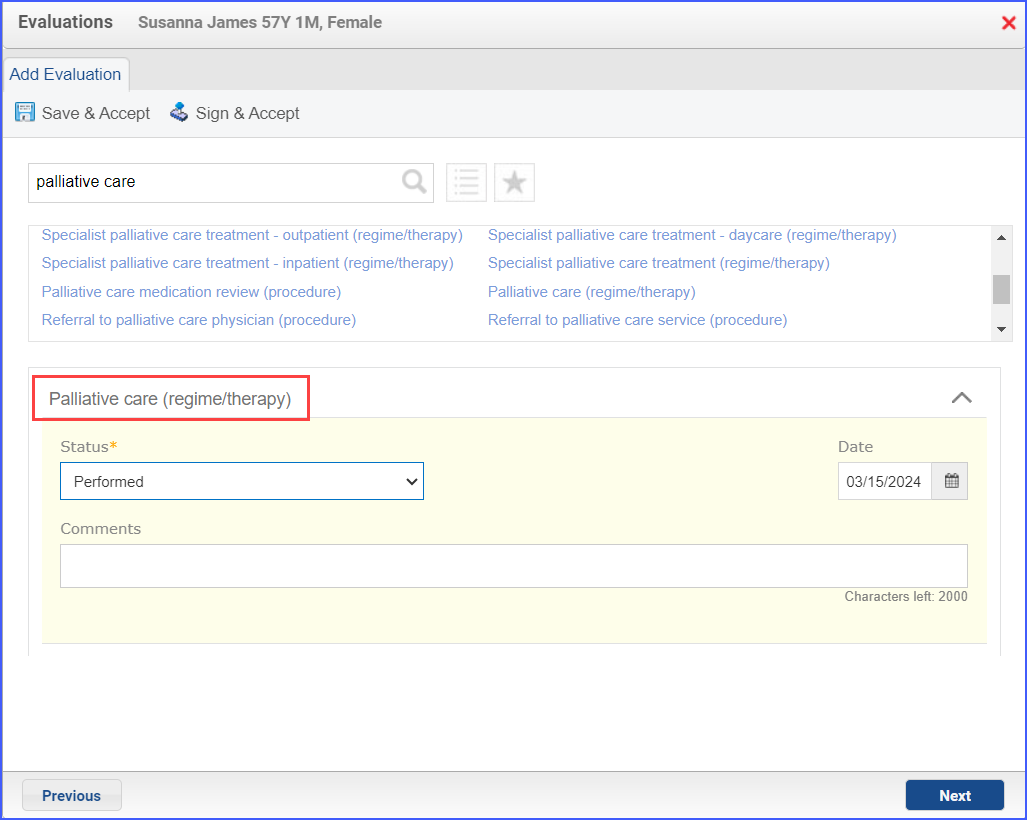
- To record the ‘Functional Assessment of Chronic Illness Therapy’ assessment, navigate to Patient > Provider Note > Evaluations.
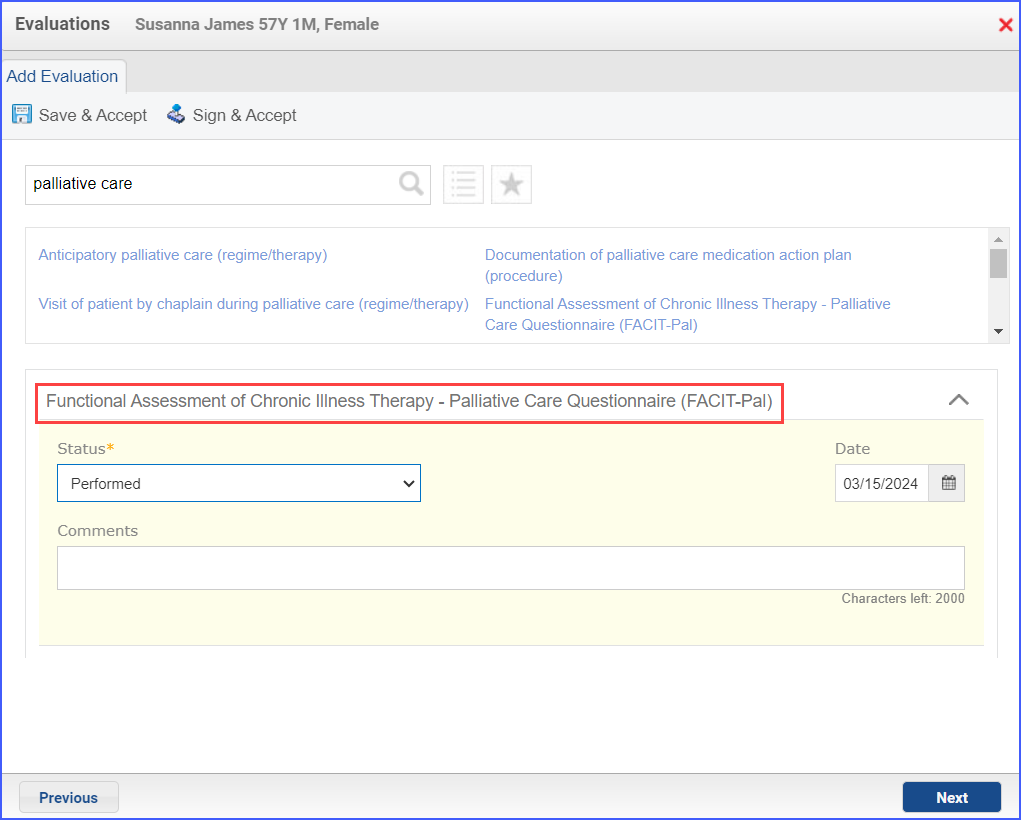
- The “Encounter for palliative care” diagnosis can be recorded via Patient > Provider Note > Diagnoses.
